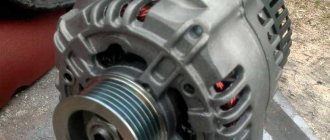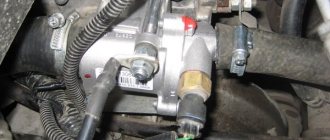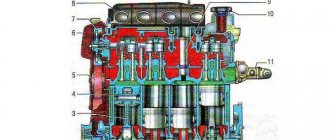The thermostat from Granta is installed on the VAZ 2110 and Priora to warm up the engine faster, especially when driving the “tens”. The thermostat is responsible for the redistribution of liquid flows in the SOD. Experts include frequent leaks and problems with the expansion tank as the disadvantages of this system on the VAZ 2110. Such malfunctions can be eliminated using tuning. The device of the SOD is preliminarily studied.
Design of LUZAR thermostats
The terms should be distinguished:
- thermostat in a broad sense (car part, thermostat in a housing, thermostat as a “function”)
- thermostat in the “commodity” sense (a replaceable part of the thermostat, can be either a thermostat in the housing or a thermoelement; what is sold as a thermostat for a given machine)
- thermoelement (“working” part of the thermostat, in some cases may coincide with the name of the thermostat in the “commodity” sense)
- temperature sensor (the executive part of the thermostat is part of the thermoelement; it is a brass cylinder with a filler that expands when heated)
An automobile thermostat consists of a temperature sensor, which is a brass cylinder with a filler (technical paraffin or thermal wax), which expands when heated, with a rod on which spring-loaded plates of the main and bypass valves are placed; the temperature sensor is rigidly fixed to the frame, through which the thermoelement can be installed in the thermostat housing. The valve discs have rubber seals.
Automotive thermostats can be cased or uncased, depending on the design laid down by the designer of the engine.
Design image
- modern automotive industry, with the increasing complexity of automobile engines, is switching to the use of electronic thermostats, where temperature control is carried out by sensors, and the thermostat valves are controlled by micromotors (LUZAR does not produce electronic thermostats)
- Many modern engines have not one, but two or more thermostats - for non-uniform temperature control in different parts of the engine.
Advantages of LUZAR thermostats
- Computer dosage of thermal wax LUZAR thermostats have thermal sensors filled using special equipment, which guarantees high accuracy of operation.
- Patented thermal sensor design To eliminate the possibility of a “breakthrough” of thermal wax from the thermal sensor body (which, according to statistics, is the most common cause of thermostat failure), LUZAR changed the configuration of the sealing gasket in the rod-thermal wax-cylinder interface. With increasing pressure, which expands when heated, the thermal wax gasket design - thanks to its specific geometry - forms an increased volume of rubber precisely in places where the thermal wax “breakthrough” may occur. This also required changing the geometry of the temperature sensor housing (“cylinder”).
- Rubberized valves We have eliminated the cause of insufficient tightness of the thermoelement - the metal-to-metal interface between the metal frame of the thermoelement and the metal valve plate - by using a rubber sealing gasket on the valve plate. Thus, LUZAR thermostats provide faster engine warm-up in winter (which is so important in Russian conditions climate).
- 100% control of thermoelements Each thermoelement is tested for temperature, height and response speed - carried out in special baths with cells.
- Warranty 2 years or 125,000 km. Mandatory certification In the event of a breakdown, you can easily replace the purchased thermostat through a retail store - just return it with a warranty card and a description of the defect. All products are certified according to the international quality management system ISO 9001 TUV and have GOST-R certificates of conformity.
Functionality check
First of all, let’s not rush to remove the thermostat, because this requires a lot of fiddling. It may turn out that we are sinning against him in vain, but the issue is something else:
- Heat. We take hold of the lower radiator pipe and let someone start the engine. If there is no assistant, then start it yourself, you will have time to hold on to the hose. Please note that the car must be cold before this. At first the pipe is naturally cold, but when the engine is running it heats up very quickly. If this happens, it means that the thermostat is working properly, installing a new one is not required yet;
- Thermocouple. If doubts remain, you will have to disassemble. From the thermostat that has already been removed, it is necessary to remove the thermoelement - it is this element that is responsible for starting the cooler in a large circle, and it is this element that needs to be checked. This happens by lowering the thermoelement into fairly hot water (about 75'C) and then heating it. Naturally, you need to lower a thermometer into the water and monitor changes in temperature and the device itself. As it approaches 90°C, the thermoelement rod must extend. That did not happen? This means that this part needs to be changed. Most often, on a VAZ 2110, replacing the entire thermostat is not necessary - it is more expensive, and moreover, it is most often necessary only if some changes are detected in the “appearance” - such as a crack, chip, etc. ;
- Replacement. If we find problems or need to change the thermostat, we go to the car market or to the store where we buy a new one. Here, too, “pitfalls” may await us - the replacement will not bring the desired result if the new thermostat is, as they say, “flawed.” You need to blow hard into the fitting. If air does not pass anywhere, then the small circuit does not allow it to pass through, and its installation on a VAZ 2110 is possible.
What engines does the VAZ 2110 come with?
The VAZ-2110 car has been produced since 1996. At the same time, the power part gradually underwent changes:
- 21100 - base model produced in 1996-2000. The car was equipped with an engine with 8 valves and a volume of 1.5 liters (power 69 hp);
- 21101 is a model produced since 2004. Engine - injection, 1.6 liters, 8 valves;
- 21102 - 8-valve engine, 1.5 liters, injector;
- 21103 - 16-valve unit, 1.5 liters, injector.
- 21103 M - 16-valve engine, 1.5 liters, injector (produced since 2002);
- 21104 - 16-valve engine, 1.6 liters, injector;
- 21104M -16-valve engine, 1.6 liters, produced since 2004;
- 21106 GTI - 16-valve engine, 2.0 liters, 150 hp;
- 2110 “Premier” - 16-valve power unit, volume -1.5 liters;
- 2110 “Consul” - limousine, volume - 1.5 liters;
- 2110-91 - rotary piston engine, 1.3 liters.
Removal
Before replacing a broken thermostat, you need to remove it:
- Unscrew the cap from the expansion tank; this is necessary so that antifreeze flows normally out of the system;
- Remove the plug from the drain hole at the bottom of the radiator tank, first replace it with a clean container and drain the antifreeze;
- Remove the entire thermostat assembly. Or, if you prefer, just its thermocouple.
In the latter case:
How to replace a thermostat on a Priora
In order to successfully replace the thermostat in a Lada Priora car, you need to prepare. You should have clean coolant and tools on hand: a Phillips screwdriver, narrow-nose pliers and a five-point hex.
On a Priora car, the thermostat is replaced using the following algorithm:
1. Unscrew the cap on the radiator and drain the coolant.
- Thermostat VAZ 2106: Replacement, Malfunctions, How to check - repair
2. To remove the Lada Priora thermostat, you will first have to loosen the clamps and disconnect the hoses that are attached to the thermostat cover.
3. Having previously unscrewed the bolts, remove the thermostat (Photo of the Priora and its engine compartment - see below).
4. Remove the thermostat cover bolts and pull it out.
5. Inspect the gasket located in the annular groove of the cover. If it is worn out, replace it.
Reassembly
After removal and testing for functionality, it is necessary to either reinstall the working thermostat on the VAZ 2110 or replace it with a new one. If you do not have a complete installation, but just replacing the fuser, then it is important to know how to properly remove it and then put it back in place.
Having removed the cover, you need to push (overcoming some spring force) the fixing plate forward using tweezers, and after turning it a little, remove the thermocouple.
Installing a new element occurs in the same way, but in reverse order.
If you decide to replace the thermostat completely, then this is also quite simple: remove the old one, replace it with a new one.
Then you need to refill the cooling system with antifreeze (antifreeze) through the expansion tank. You can fill in either filtered antifreeze (if it is not yet time to fill in a new one, the old one has retained its color and texture) or new liquid.
To eliminate air jams that may appear, you should start the VAZ 2110, let it run until it warms up, at idle speed. This eliminates air pockets and, in fact, the entire installation is completed.
Finally, just check if there are any leaks, if the coolant level in the tank has dropped (it should be at the top edge of the fastening strap), top up if necessary.
The VAZ 2110 thermostat (either the original one or the more efficient one from the Lada Granta) is very easy to replace yourself in cases where it breaks down.
Refinement of a budget car
You can install a thermostat from Granta to Priora. To do this, you will need to buy pipes, a gasket, a tee, a temperature sensor, studs, and antifreeze. Since the Granta, unlike the Priora, has a radiator located further from the engine, a long pipe will be required for tuning.
You can splice standard pipes. To do this, use the SOD pump pipe from the “ten”. A straight section with fasteners is cut off from it. Experts attribute the advantages of such tuning to the rapid warming up of the interior and engine; the operating temperature of the internal combustion engine fluctuates within 92°C.
In order to correctly modify the ODS on the VAZ 2110 and Priora, it is recommended to use a book on the operation of these vehicles.
If necessary, it is recommended to consult with auto mechanics.
Many VAZ-2110 car owners are not satisfied with the operation of their vehicle’s thermostat, and especially with the fact that it does not heat the stove. In this case, there is only one way out - replacing the original part with a thermostat from the Lada Granta.
The video material will tell you how to complete the process of replacing the original VAZ-2110 thermostat with a thermostat from the Lada Granta to ensure a better heating effect for the interior. Also a little about the merits of this replacement.
Checking the thermostat VAZ 2110 (injector)
Probably every more or less experienced driver knows that a thermostat is a device that is responsible for the competent redistribution of liquid flows in.
During active operation of the machine, this device may jam on a small or large circulation circle, which will cause underheating or overheating of the motor.
It is clear that a vehicle with a faulty cooling system cannot be used, which means that the owner of the car will have to replace the device that has failed.
But before that, you should make sure that such a replacement is really necessary. That is, you need to check the thermostat for functionality. This is done without dismantling the engine in this way: we start the engine and direct all our attention to the instrument panel, where the temperature of the cooling fluid is displayed. The main valve of the device we are interested in opens at a temperature from +83 to +87 °C. If the engine has a lower temperature, the liquid moves in a small circle (that is, the valve is in a closed state).
The most effective ways to modify the Lada Granta thermostat with your own hands
No. 1 Adjust the stroke of the thermoelement
After dismantling the flow regulator, we disassemble it into its component elements:
- case cover;
- spring;
- metal plate;
- retaining ring;
- thermocouple
We clamp the thermoelement in a vice, use a file to file the rod to 1.0 - 1.5 mm, no more. We do this extremely carefully, since the material of the part is soft.
After each point we assemble the structure in the reverse order. We fill the system with antifreeze, start the engine, check the activation threshold of the valve, the return pipe will be warmer than usual.
We repeat the procedure again and again until the thermostat activation threshold approaches 87 - 90°C. Modification of the thermostat on the Lada Grant 2190 without replacing the thermoelement has been completed.
How is the VAZ 2110 thermostat replaced?
The procedure flow is as follows:
- the car battery is dismantled;
- the plug is removed from the expansion tank;
- unscrew the drain plug located at the bottom of the radiator;
- The liquid is drained from the tank, after which the plug can be tightened;
- the hose clamps on the thermostat pipes are loosened;
- hoses are dismantled (both rear and front);
- unscrew the bolts (there are three of them) that secure the thermostat cover and remove it.
In order to remove the thermostat from the cover, it is best to install the latter in a bench vice (you will need to mount jaws or soft pads on them to protect the aluminum surface from scratches). After this, press down the thermostat fixing plate (the spring will resist, you will have to apply some force), turn it and remove it from the grooves. Now the device we are interested in can be easily removed. And in its place you can install a new one, proceeding in the reverse order.
Before replacing the element we are interested in, experts advise allowing the engine to cool completely after operation. And after the old thermostat has been removed, you should definitely check the new device for serviceability.
This is done like this:
As you know, on a VAZ 2110, replacing the injector thermostat is an important and responsible procedure. The thermostat performs the most important functions related to the engine cooling system. On a VAZ 2110 injector, replacing the thermostat can be easily done on your own.
How to Install a New Thermostat
If the best device for the VAZ-2110 has already been purchased, it’s time to start installation, especially since you can carry out the procedure yourself. You will need:
- gasket former - cost about 300 rubles;
- Cooling system cleaner – 150 rubles;
- pipes going to the stove radiator - 230 rubles;
- thermostat (in our case it’s Pramo) – 12,000 rubles;
- green antifreeze with a volume of 10 liters - up to 900 rubles;
- hairpin M8 at 70 m.
First you need to drain the used antifreeze. Place a 7-liter container under the drain hole and wait until the liquid is completely drained into the container. After this, you should clean the cooling system; for this it is best to use a special cleaning agent. Acids, soda and vinegar do not give such a good result, and lactic acid can ruin the internal parts of the car.
After pouring in the cleaning agent, add water inside and turn on the VAZ-2110 for 20 minutes. This promotes rapid detachment of contaminants and scale from the pipeline walls. The expansion tank should also be thoroughly rinsed. Now loosen the clamps of the hose coming from the radiator, then do the same with the clamps of the supply hose of the pump pipe and the hose that serves as the connecting element between the outlet pipe and the thermostat.
Remove the thermostat, install a new sample and repeat everything in reverse order. Don't forget to add coolant.
General information
The thermostat is truly a very important part of the car. If it weren’t for him, the engine would constantly be subject to overheating, and the dire consequences of this are only unknown to a person completely far from the car. When the unit overheats, the cylinder head gaskets burn out, the properties of the oil removal caps change, etc. In a word, when the engine overheats, expensive and serious repairs are always expected. In order to protect the engine, engineers came up with a cooling system that maintains almost the same temperature during engine operation.
The role of the thermostat
The function of the thermostat on both injection and conventional engines is known. This element of the system regulates the temperature, which constantly circulates throughout the system.
What is a thermostat
Usually this is a cylindrical part that has three outlets:
- The inlet pipe, which is located at the top of the thermostat;
- Inlet pipe from the radiator (see), which is located at the bottom of the part;
- Outlet pipe located on the side.
Principle of operation
The operating principle of the thermostat is characterized by the following points:
- Inside the thermostat there is a valve filled with a special substance. This very substance, due to its chemical and physical properties, expands with changes in temperature. Thus, when the substance expands, it acts on the valve, which overcomes the force of the spring and opens the flow of fluid from the radiator to the outlet - the outlet pipe.
- In addition, the design of the thermostat implies the presence of a bypass valve located on the antifreeze path from the engine to the outlet pipe.
- It is noteworthy that at a time when the antifreeze temperature is low and the engine is running but not warmed up enough, the coolant circulates in the so-called “small circle”.
Note. A “small circle” of coolant passage implies the opening of the bypass valve, resulting in rapid warming up of the engine.
- The main valve opening begins at temperatures between 80.6 and 81.5 degrees. It is at this moment that the liquid begins to move in a large circle, implying circulation through the radiator.
- When the temperature reaches 94 degrees, the main valve opens to its maximum value, approximately 6 mm. In this case, the bypass valve closes completely, and the coolant moves only in a large circle and is automatically cooled as it passes.
Note. In most cases, failure of the thermostat implies jamming of the valve stem, which naturally leads to the circulation of coolant in either a small or large circle. If the movement of antifreeze in a large circle is not so dangerous, then the first case threatens to overheat the automobile unit. How to check the thermostat status
The simple test below will help you do this:
- The engine warms up to operating temperature (the arrow should be vertical);
- We feel the lower thermostat pipe with our hand, which should be slightly warm and gradually warm up.
If the lower pipe is cold, then most likely the thermostat is not functioning normally and the liquid circulates only in a small circle. If the lower and upper pipes have similar temperatures, then the probability of the valve being open is one hundred percent.
No. 3 Modification of the thermostat on the Lada Grant - heating the throttle valve
The throttle valve on the Lada Granta is not heated. In winter, in severe frosts, metal structures slightly grab, which is noticeable while driving a car.
There is only one way to protect the unit from freezing - to run the circuit from the cooling system.
Sequencing
- We place the car on the inspection hole and remove the metal protection of the oil pan.
- Drain the antifreeze.
- We release the clamps - ties, remove the rubber supply and return pipes.
- We dismantle the flow regulator, fix it in a vice, and disassemble it into its component elements.
- In the back of the case we drill an additional hole at “10”.
- Using argon welding, we weld the fitting to the hole for partial intake of antifreeze from the thermostat (Luzar).
- We assemble the structure.
- We put the rubber pipe on the fitting.
- We fill the system with antifreeze.
- We start the engine and test the proper operation of the stove heater.
Replacing the thermostat yourself
The process is not particularly difficult. It is imperative to check the condition of the thermostat before replacing it, because otherwise there is no point in spending extra money. How to check the thermostat was described above.
Removing the thermostat from the car
- We arm ourselves with the necessary tools (6 hex wrench, 8 wrench, screwdriver, etc.).
Attention! All work should be carried out only on a cold engine, so as not to inadvertently get burned by the liquid.
- Drain the coolant;
- We remove;
- Find the radiator hose clamp and loosen it;
- Disconnect the hose from the thermostat;
- Using the same method, we release the coolant pump hose;
- Now we take the key to number 5 and unscrew the bolts securing the thermostat (there should be 3 of them);
- Remove the thermostat cover;
- The thermostat itself is removed from the cover, as well as the rubber sealing ring.
Installation
On the VAZ 2110 you can easily install a thermostat from the injection VAZ 2111. The advantages of such an upgrade:
- You will have to use one less hose and only two clamps, which minimizes the possibility of leakage;
- Smaller dimensions;
- Compact monoblock design;
- Large circulation through the stove due to the reduced cross-section of the small circuit;
- Placing the expansion tank in a convenient place, which allows you not to heat the engine until the thermostat opens;
- Relatively simple procedure for replacing a new thermostat.
What you need for installation
- Coolant sensor or plug bolt of the appropriate type;
- Long hairpin on M8;
- New thermostat;
- Gaskets and two clamps.
Installation algorithm
- First, you will have to cut a special tee into the supply hose of the stove (this is done due to the fact that the thermostat may have five fittings, which does not have access to the expansion tank, but needs six);
- We dismantle the distributor to make it more convenient to work (if the engine is carburetor, if it is injection, there is no need to remove anything).
Replacement process
The process of replacing the thermostat is simple and will not take much time, but the result will not be long in coming.
What is needed for replacement:
- Grant thermostat
- Gasket between thermostat and block
- Sealant
- Coolant
- Lower radiator pipe Grant
- Tee for stove VAZ 2108
- New clamps (it is best to use spring clamps)
- Two M8x80 studs (or a bolt of the same diameter and length)
Installation process:
- We prepare the car, remove the air filter box along with the corrugation and mass air flow sensor, and drain the antifreeze.
- Then we remove the old thermostat.
- If the Priora has a mechanical throttle, then we turn off the hoses going to heat it using an M8 bolt and a clamp. If the throttle is electronic, you don't need to do anything.
- We install new studs in the thermostat mounting points.
- Changing the lower radiator hose from the standard one to the Grant one
- We install the new thermostat, first placing the gasket on the studs.
- We connect the hoses according to the diagram
Grant thermostat connection diagram
- The inlet pipe to the heater radiator is connected from the thermostat, and the radiator outlet pipe is connected to the pump pipe.
- The outlet pipe is cut and a tee is inserted into it through which the expansion tank will be connected
- We unscrew the coolant temperature sensor from the old thermostat and install it in the new one.
- Filling with coolant
Then we start the engine and monitor the coolant level as the temperature increases, the liquid will decrease, do not forget to add coolant to the level until it stops decreasing.
Modification of the thermostat
On a VAZ 2110, it is quite possible to modify the thermostat by adding another hole to the 5-hole device. Why is this needed and what does it give?
- In cars, in particular on the VAZ 2110, the injector becomes warmer with the advent of the sixth fitting due to the fact that the bypass channel decreases. For reference: a bypass is a pump for circulating liquid in a parallel pipeline;
- For the stove to operate, it is necessary for the coolant to circulate in a small circle. This happens through the bypass channel. The smaller its diameter, the more liquid will flow through the stove;
- An additional fitting, as a rule, prevents the heater return tee from leaking, since such malfunctions are not uncommon on “tens”.
An additional 8 mm hole is drilled in the body of the vehicle (thermostat). Install an additional pipe parallel to the same one going to the stove. It is needed so that the “waste” liquid from the heater enters the thermostat cavity, and there is no overcooling of the engine.
You also need a throttle washer - to increase the flow of fluid through the stove if the small circle is open, and an adjusting bolt resting on the leg of the element in order to regulate the opening temperature of the vehicle from the outside.
By the way, having modified it in this way, you can turn the carburetor TS 82, by drilling and tapping, into an injector suitable for the VAZ 2110.
Technical points
Regardless of the vehicle brand, the ODS consists of the following elements:
- Water pump.
- Electric fan.
- Radiator.
- Expansion tank with plug.
- Thermostat.
On a cold engine, the valve of the latter device closes the pipe going to the radiator. In this case, coolant circulation is observed in a small circle (without a radiator). On the “ten”, the radiator, intake manifold, BDK, and liquid chamber are involved in a small circle. At a temperature of 87°C, movement of the thermostat is observed. This opens the main pipe. The liquid begins to circulate in a large circle. If the temperature reaches 102°C, then the pipe opens completely. The valve stroke is allowed within 8 mm.
SOD Priors and Grants are liquid, closed and with forced circulation. The liquid enters the thermostat through a deposit and a special jacket.
Narrowing of the bypass channel
If you decide that it is the bypass channel on the VAZ 2110 that needs to be adjusted, then the 6-hole thermostat should not have any problems. But with a 5-hole one, malfunctions may occur due to the fact that the cold pipe of the stove (outlet) will not be washed. Therefore, think about whether you need such a modification; maybe it’s better to immediately install a Granta thermostat or a six-hole one.
To reduce the bypass, you need to do the following:
- Cut a plate out of sheet aluminum so that it fits exactly inside the vehicle;
- Secure the plate with a rivet or cold welding, but so that the fastening does not interfere with the flow of coolant in a small circle;
- In this plate you need to drill a new hole of 5 or 6 mm (instead of the standard 8 mm);
- In addition to the steps described above, on a 6-hole heater, the stove return is connected to a thermostat.
After this modification, you will notice that the interior will warm up better and faster, but engine warming up will slow down somewhat.
How does the VAZ-2110 engine cooling system differ from Granta?
Using diagrams that are easy to find on the Internet, you can trace the difference in the engine cooling systems of the VAZ-2110 and Grants.
In the VAZ-2110 car, experienced car enthusiasts note a number of shortcomings in the operation of the thermostat device. First of all, these include:
- Frequent leaks of coolant from the engine cooling system.
- Problems with the expansion tank.
But the Granta cooling system is different in that it:
- liquid;
- closed;
- with forced circulation.
In this case, the coolant enters the thermostat element through the pump.
The main differences between the engine cooling systems of both cars are:
- In Granta, the stove is connected in a sequential manner (as a result of this connection, the number of revolutions of the pump does not have any effect on the heating device called “stove”; there is no process of heating the coolant in the radiator and expansion tank).
- For the VAZ-2110, the stove is connected in parallel.
Installation of a modified vehicle
On a VAZ 2110 you can easily install a more advanced thermostat from Granta 2190. But you should still know a little about the design of the heating/cooling system in Granta. Its scheme can be easily implemented on the “ten”.
- Original TS Grants 2190 from BEHR;
- The lower radiator hose is from Granta, but the upper one 21214 will also work, or simply matched to size;
- Tee from VAZ 2110 for the cooling system;
- The studs are 8 mm in length - like from the camshaft bed;
- Straight long stove pipe from the “ten”;
- Gasket for thermostat.
We act according to this plan:
- We change the lower radiator pipe to the one from Granta (or similar). You can leave the original one, but connect it to a suitable diameter at a right angle using a piece of pipe. However, remember - the more connections, the more opportunities for leaks;
- We connect the expansion tank pipe through a VAZ 2110 tee: one end goes to the drain from the heater radiator, the other end goes to the supply pipe;
- Drain the coolant;
- We change the studs to longer ones and install the Granta thermostat;
- We twist the temperature sensor.
Installation of the Grants thermostat on VAZ 2110, 2112
| It is no secret that the production of VAZ cars of the tenth family in Russia has already been completed. However, nothing prevents owners from improving their cars by replacing outdated parts with more modern ones, from foreign cars or VAZs of the latest years of production. An example of this would be replacing a VAZ 2110 thermostat with a Lada Granta thermostat. |
Will need to buy
- Thermostat Lada Granta (catalog number: 21900-1306010-00), price 640 rub.
- Gasket for the thermostat (same as standard), price 8 rubles.
- Lower radiator pipe for Lada Granta (1 self-tightening clamp included), price 440 rub.
- M8 studs, approximately 85mm long, price 20r.
Replacing the thermostat
All that remains is to pour new antifreeze into the cooling system and start the engine. During warming up, monitor the temperature of the antifreeze and the tightness of all connections.
Conclusion
Based on observations, we can say that the stove begins to blow warm air already at 55 degrees of coolant, and at a temperature of 70 degrees hot air is already coming from the stove (not only while driving, but also at idle). While driving, the engine temperature is kept between 85-90 degrees. In traffic jams, the engine does not overheat, and the temperature ranges from 95 to 105 degrees, the radiator fan of the cooling system turns on.
More detailed observations are described on the forum. By the way, the SOD on the “ten” can also be remade according to the Lada Kalina type.
| I remade the SOD VAZ 2110 according to the Grants scheme and Which Granta thermostat connection diagram is best to choose? |
Photo source: Key words:











